UPDATE: April 2015. DO NOT BUY. Device still does not work, even with a new iPhone. App has never been updated in the App Store.
UPDATE: Nov 24, 2014. DO NOT BUY. Have had continuous problems with this device not pairing and it has been less than 3 months.
Customer service was helpful for the first 3 calls, then basically told me on the 4th call that I was out of luck and should wait for a future (unscheduled) app store update that, if I’m lucky, will fix the issues. I have never had so many problems, and cannot believe they did not offer to replace it, but upon my asking directly, they did not think a replacement would fix the issues. DO NOT BUY.
The Under Armour Armour39 Heart Rate Monitor is an excellent new addition to the heart rate monitor market. It consists of a chest strap and transmitter which pairs with an app on your iPhone or iPod Touch (or can pair with a watch purchased separately).
Overall, I think it’s a winner and a good buy, and I detail the pros & cons below.
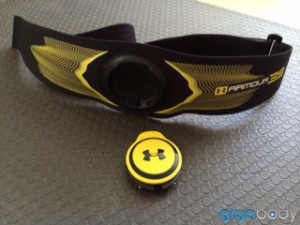
Pros
1. The app picks up your heart rate even several feet away from your phone.
Whether on a run with my phone in hand or working out at home with the phone 4 feet away, the Armour39 app picks up my heart rate like a champ. I haven’t tested how far away the bluetooth connection will work, though I was told by a sales rep it can work across a room. I like to keep my phone in visible range in case I want to spot check my heart rate or calorie burn.
2. The Armour39 app metrics are motivating.
The app has a variety of metrics of interest, both during your workout and afterward.
During your exercise, the app shows the following real-time:
- heart rate
- calorie burn
- “willpower”
- duration
- intensity
Intensity appears to map closely to your heart rate zone, with 100% intensity mapping to your max heart rate, while Willpower is an invented 0-10 metric that seeks to represent how committed you are to pushing your limits. Willpower is defined by Armour39 as a combination of your intensity, movement, duration, and heart rate, and I find that it rises with a sustained high heart rate as well as interval training bursts. You can set up the app to aim for a willpower target, though I haven’t tried this. I like to rely on my internal willpower & motivation.
After your workout, Armour39 displays these helpful & rewarding stats:
- average & peak heart rate
- average intensity
- overall calorie burn
- willpower score
- workout duration
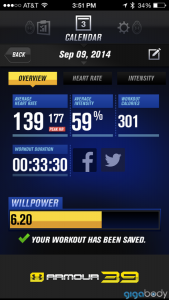
You can also see how your intensity and heart rate varied over the course of the workout.
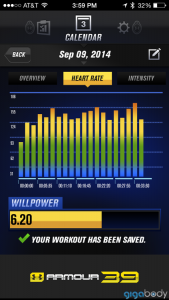
3. The heart rate numbers let you quantify exercise missed by accelerometers and activity trackers.
A great benefit of heart rate tracking, for Armour39 and Heart Rate Monitors (HRMs) in general, is that they let you quantify some of the impact of activities that don’t involve a lot of steps or movement. Accelerometers (in phones), pedometers, and wearables (like the UP & Fitbit) don’t do a good job recognizing strength training, reps, or activities like workout videos, yoga, and pilates. Heart rate tracking, however, does.
4. The heart rate numbers are reliable.
I find the Armour39 heart rate numbers reported quite accurate. I’ve extensively used Polar & Timex heart rate monitors in the past to track my running & strength training. I’ve not only trained in particular zones, but have learned to recognize the physical signs that correspond to my different heart rates. The Armour39 numbers are right in line with my expectations.
5. The battery is easy to change (and Customer Service is awesome)!
One of the biggest problems with top heart rate monitors on the market is the ease with which consumers can change the batteries. By nature, these are battery hungry devices so this SHOULD be one of the simplest things to do, and yet it never is. Many models require an authorized dealer to replace the batteries for you lest you void the warranty, then charge exorbitant prices to do so. Changing batteries can be complex and can easily ruin the product. In this arena, Armour 39 is a champ. I use the iPhone app (not the separately available watch) so there’s only 1 battery for me to worry about – the battery in the transmitter. All you need to change the battery is a coin and a standard watch battery available at every drugstore & hardware store.
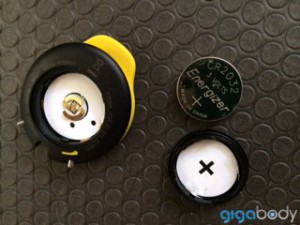
One note of caution – That plus sign that you see at bottom right is a weird little insert inside the battery compartment of the Armour39, a piece of sticky paper with metal conductors on it. I mistakenly thought this was part of the new product packaging, a temporary part to be removed, so I couldn’t figure out why my replacement battery wouldn’t work. It wasn’t the installation – that part was simple. I needed to restore this insert. I called Armour39 customer support and talked to probably the nicest woman I’ve ever met. She quickly figured out my error, and with not a hint of condescension, got me up and running with a smile on my face. She actually made my day better!
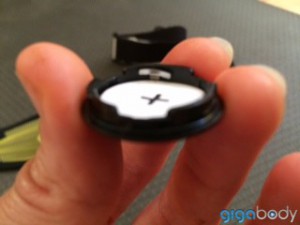
6. The chest strap is a winner.
I find the chest strap very comfortable and easy to use. The parts feel substantial and well made, and the tactile feedback is just right when you snap the transmitter in and out of the strap: a satisfyingly smooth & secure experience. Well done, designers!
It’s simple to rinse the strap (after removing the transmitter) to remove any sweat buildup. My strap “lives” on the towel rack.
Cons
1. You have to remember to remove the transmitter from the strap or your battery dies.
Well, I learned the hard way when I first set up my device that you cannot leave the transmitter in the chest strap. My battery died. It was the pre-installed battery, so it was of unknown age & origin, probably not fully charged to begin with. Still, I set the app up & paired it with the device in preparation for future use, not use right that moment. So did my friend. This seems to be normal behavior when there is one-time setup involved (very quick setup by the way). The manual did not have a bold, highlighted warning saying HEY STUPID, DO NOT EVER LEAVE THE TRANSMITTER IN THE STRAP. I wish it had. Because the first time I went to use it, maybe a week later, it was dead.
The app itself has a reminder after you save every workout to remove the transmitter. That’s an excellent moment to remind folks. But it should also be prevalent in the setup manual itself, so that the first impression is not a bad one.
Side note: I forgot to remove the transmitter once with my new battery. Left it in for about 4 days. This time, the strap still worked. So as long as you don’t forget for too long, there’s some wiggle room with this rule. Probably best to spend the extra buck for a 2-pack of the batteries though, just in case.
2. You have to remember to put the transmitter back into the strap when you exercise.
Ok, so now I’ve gotten decent at remembering to remove the transmitter when I take off & rinse the strap after use. However, this does not make me remember to put the transmitter back in. Honestly, I have about a 50% success rate remembering the transmitter when I head out the door with the chest strap securely on. And then I don’t realize until the app won’t connect that I’m missing the transmitter.
I’m not a dummy, but I already have a lot to remember. When I go for a first-thing-in-the-morning run on a sleepy brain, EVERY SINGLE TIME I have to remember an entire checklist of things. Apply sunscreen, put on the chest strap, (find & snap in the transmitter!!) , grab the dog leash, put it on the dog, pick up my headphones, grab my iphone & attach to headphones, pack a tissue, get the house key, quickly update my podcasts, make sure I’m wearing my Jawbone Up, put on my running shoes, get out the door with the dog & try not to get tangled. It’s not just “one thing” to remember.
I’d like to see UnderArmour address this. Either update the transmitter to consume less battery power when not paired to the phone so it can remain in the chest strap OR add a way to keep the transmitter attached to the chest strap when it’s popped out. Connect it with a detachable loop or something, so the two parts stay together and function as one. Pretty please?
3. Willpower in the app does not correspond to mental willpower.
I am impatient. Terribly impatient. When I work out, I want to sweat, drip, burn mega calories and get it done. I’m the queen of the 35 minute daily workout. Needless to say, yoga’s not so much my thing. I enjoy the movement and poses, the twists and stretches, just not the pacing. So, when I recently did a 72 minute yoga video, it took A LOT of willpower. It was a good one too: my arms were burning from all the vinyasas and pushups, but the class was just so long. Oh, how I wanted to quit at the 56 minute mark – it just seemed to go on forever. I pushed through it, out of respect for the teacher and to challenge myself. My willpower rating according to Armour 39? 2 (out of 10). Wrong!
Compare this to 2 other workouts I did the same week: a 33 minute weight-training workout video and a long slow jog of similar duration to the yoga class. Important note, the workout video took very little motivation on my part. This is a type of workout I love to do, not too long in duration, quick & intense. The run definitely took some willpower, because running is hard for me. I’m built for strength and bursts, not endurance activity. According to my 23andMe genetic profile, I have quick twitch muscle fiber, associated with sprinters not endurance athletes. That said, I run fairly often along a stunning waterfront in sunny California – this is not at all boring so willpower is not a major hurdle.
Here are my Armour39 stats for these 3 workouts:
| Yoga | Strength Training | Jog | |
|---|---|---|---|
| Average Heart Rate | 92 | 139 | 155 |
| Peak Heart Rate | 178 | 177 | 183 |
| Average Intensity | 0% | 59% | 80% |
| Workout Calories | 263 | 301 | 868 |
| Workout Duration | 1:12:01 | 0:33:30 | 1:21:17 |
| Armour 39 Willpower | 2.31 | 6.20 | 9.84 |
| My Perceived Willpower | 9 | 2 | 7.5 |
As you can see, the awarded willpower does not map to the willpower I felt the different tasks required, mental willpower that is. Intensity is also not a very reliable indicator for slow, subtle movements like yoga. Holding yoga poses, balancing, and doing inversions is definitely intense as evidenced by my peak heart rate, but not intense in a way that registers for Armour 39.
That said, these metrics are still helpful, and definitely motivating.
4.The app only integrates with MapMyRun so far, not Runkeeper, Strava, or other wearables.
In late 2013, UnderArmour purchased MapMyFitness. This was a fantastic investment on their part, a great running start entrance into the mobile fitness market. However, I’m a RunKeeper girl. I tried a bunch of the apps when I started running in 2012, and RunKeeper was my clear favorite. RunKeeper has wonderful audio cues, no invasive ads in the free version, and excellent analytics for tracking progress.
So for now, I’m using RunKeeper & Armour39 apps side by side on my iphone, wearing my Up bracelet and my Armour 39 chest strap. I would LOVE for Armour39 to integrate with more devices and more apps in the future, to simplify my health tracking into a more holistic landscape where everyone just gets along.
Heads Up
Calorie counts vary between devices and apps.
After 6 weeks of use, I’m satisfied that the Armour39 calorie counts are pretty accurate, despite concern early on that the numbers might be slightly high. I’ve now measured a wide range of activities, from walking the dog, to dancing, kickboxing, strength training, jogging, and yoga.
Yet check out the calorie counts estimated by different iPhone Apps for the same jog:
| Armour 39 | RunKeeper | Jawbone Up (linked to RunKeeper) | MyFitnessPal (linked to RunKeeper & Jawbone Up) | MyFitnessPal (manual lookup for a 12min mile) |
|---|---|---|---|---|
| 868 cal | 608 cal | 833 cal | 756 cal | 661 cal |
Why the discrepancies?
- RunKeeper is reporting on less activity because it’s paused when I take breaks as well as before and after my actual run. Because RunKeeper measures my pace per mile (and compares this with my past runs), I disable it whenever I’m not fully running, so that my computed run pace is not penalized. Armour39 and the Up band are tracking during breaks and my walking/stretching cooldown (in this case for 11 extra minutes). My heart rate is still zooming, and the calories are still burning.
- Armour 39 has access to more insightful (heart rate) data that the other apps do not. Standard exercise->calorie tables you find online and in calorie tracking apps consider my >12-min/mi jogging pace very slow & easy. But because of my fast twitch muscle fiber, body composition, and weight distribution, a “light” pace for others is quite vigorous for me, at the heart rate level. Armour39 detects that my heart rate is in the 150s and above, and adjusts accordingly.
If I manually try to enter my run into MyFitnessPal, my >12-min pace is not even listed in their system, because no one on earth who tracks calories could possibly run that slowly except me. Yah right. - MyFitnessPal is simply combining the connected RunKeeper+Jawbone data, so it’s not really computing the calorie count directly. The merged number is still far more accurate than using a manual lookup of slow running in their database (as seen above).
On this particular day, Armour39 awarded more calories than my Jawbone Up for this run, but these two are just as frequently reversed.
Bottom Line
The Armour39 is my favorite heart rate monitor yet. Due to the abundance of metrics, the ease of care & changing the battery, the relatively inexpensive price point, and the fact that the app can be continuously updated through the app store, I think it’s a great buy. I love not having to deal with a separate watch & a tiny, confusing watch interface. Obviously without the watch, the device is only good as long as the app remains available and up to date for the latest iPhone hardware and software. It’s critical that UnderArmour prioritizes this app support. And it begs the the question – will the Armour39 work with the Apple Watch?
It’s too early to forecast how well the product will age. With other heart rate monitors, I’ve found increasing inconsistencies with age, times when the transmitter won’t pick up the signal or when the numbers go beserk (and say my heart rate is in the 200s). So far, no such problems with Armour39. My only concern at this point is with the longevity of the paper/metal insert inside the battery chamber – whether that will hold up, and through how many battery changes. It will be interesting to report back in a year.
UPDATE: After < 3 months of only occasional use, 4 calls to customer service, I have a non-functional device that simply will not pair with my iPhone 5s, with no solution in sight. This outcome pretty much could not be worse. Regardless of whether the fault lies with the software or the hardware, it’s broken. Save your money & AVOID the Armour 39.
Okay, I thought it was just me. I was also never able to get it to sync after using it during the IDEA Expo last year. Thanks for the post.
Thanks for your comment! Such a bummer — it was great when it worked. I’m still hoping they revisit it. It was really quite unique. But with all the technology companies they’ve acquired in the last few years, who knows.
Thank you for sharing this great blog.